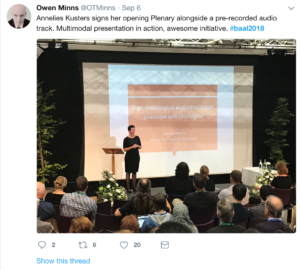By: Annelies Kusters and Jemina Napier
International Sign version: https://vimeo.com/289892708
This blogpost was originally posted on the Mobile Deaf website on Friday 14th September 2018. See: http://mobiledeaf.org.uk/on-audio/
Annelies:
What do people think when they see a signing person on stage, and hear a simultaneous interpretation?
On Thursday 6 September, I gave a keynote presentation at BAAL titled “Sign multilingual and translingual practices and ideologies”. It was the first presentation of the conference and a number of people tweeted. One of the tweets read:

I wasn’t using a pre-recorded audio-file from which I was interpreting myself. I am a deaf scholar. I presented in British Sign Language and was interpreted into spoken English by Jemina Napier. This is the typical practice for deaf academics presenting at conferences.
My deaf colleagues, the team of interpreters and I initially laughed at the misunderstanding, and the Tweeter also realised his mistake quickly, writing:

However, rather than just waving it away as the umpteenth ignorant comment about deaf people, another funny anecdote to share with my friends, this also made me think. I am in a pivotal moment in my academic career in that I’m becoming more visible. Did it even occur to the Tweeter that I was deaf, and that me signing my presentation in British Sign Language was not an attempt at being innovative but simply the best option at hand (sic) for me? In other words: why not assume immediately that this signing person on stage in a mainstream conference is most probably deaf? Do people not think that deaf people can be academics who can get invited as keynote presenters in this kind of conferences?
Example two. During one of the breaks at the same BAAL conference, another scholar from another British university approached me. He said he had seen me on the screen: the hall where the keynote happened was full and he was watching the livestream in another room. Apparently he initially thought I was speaking and signing at the same time, and was puzzled about my Australian accent. Only later, he realised that I was working with an interpreter (and if I would have an accent in English, a language I do write but not speak, it would certainly not sound Australian!).
Example three. After another applied linguistics conference where I gave a keynote earlier this year, the TLANG closing event, someone wrote about my keynote presentation “Her keynote was an especially engaging end to the day as it was impressively and seamlessly presented in both sign language and spoken English.“ (https://channelviewpublications.wordpress.com/2018/04/04/communication-in-the-multilingual-city-the-tlang-conference/)
At that conference, I was interpreted into English by Christopher Stone. A simultaneous interpretation is not a simultaneous presentation1.
Example four. I taught in a summer school in Denmark a few years ago. I was teaching in International Sign and two interpreters were interpreting into spoken English. Several students thought that the interpreters were the teachers, and that I was the interpreter. And this was on (already) day three of the five day summer school. Go figure.
